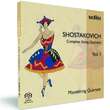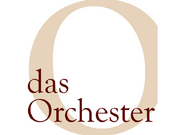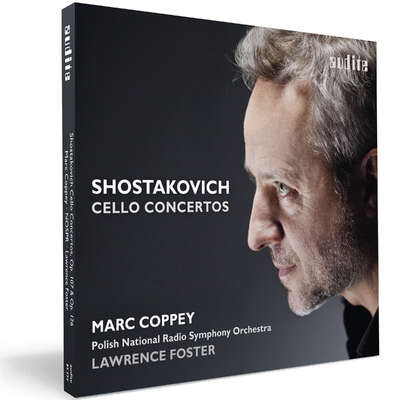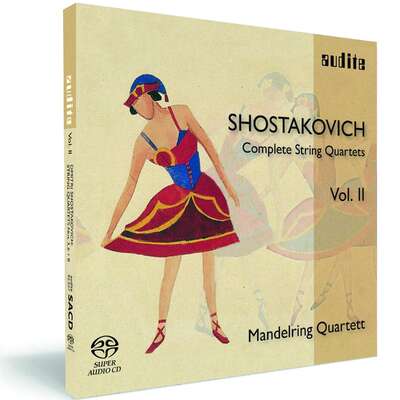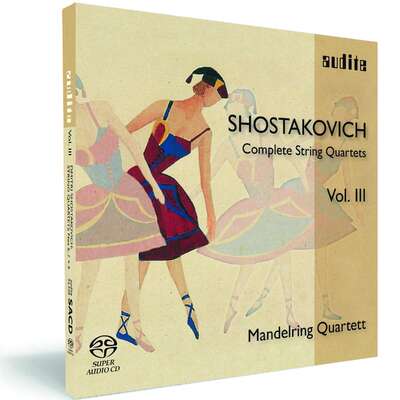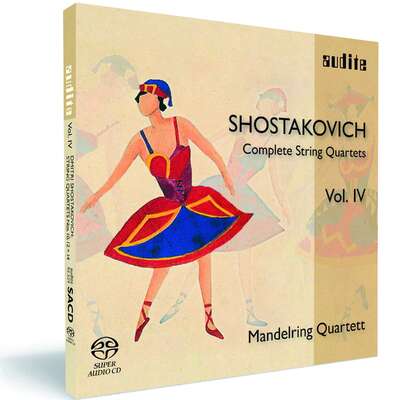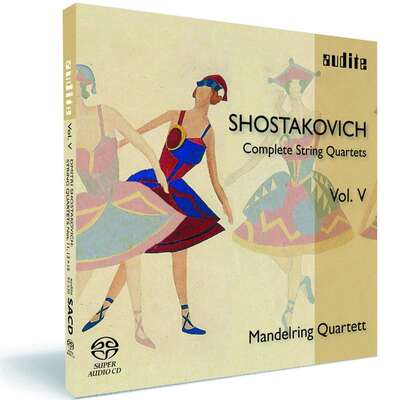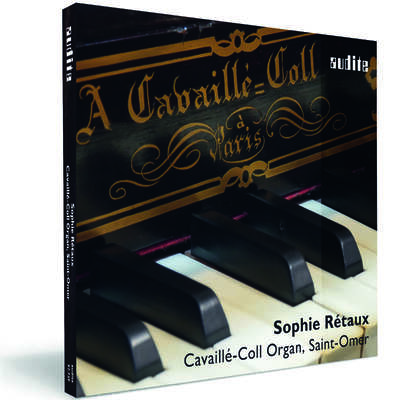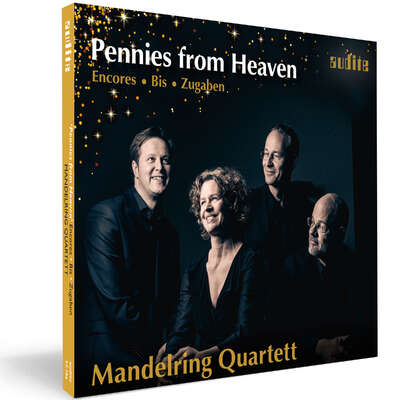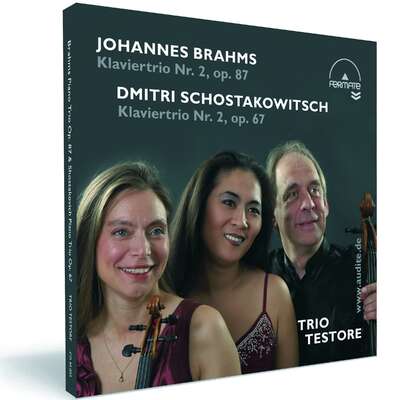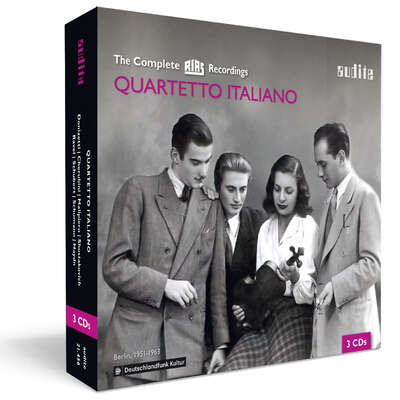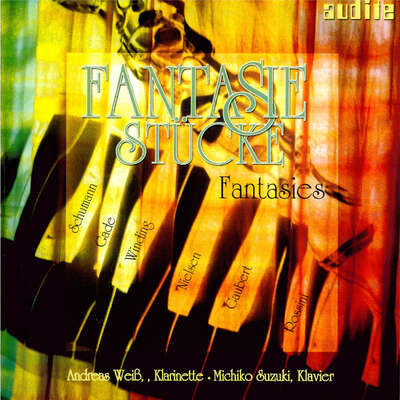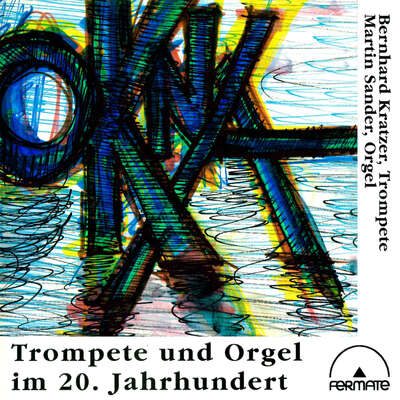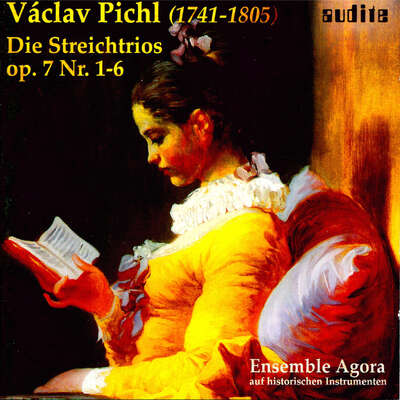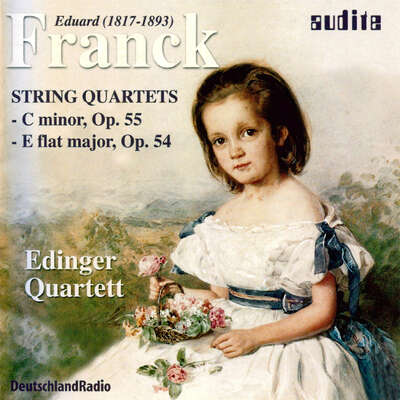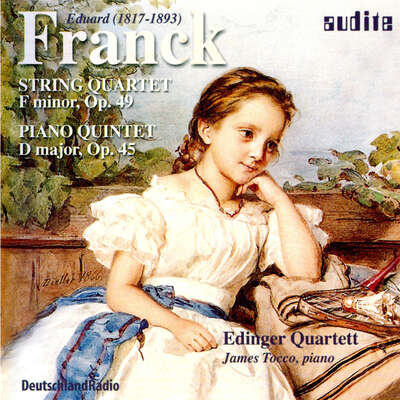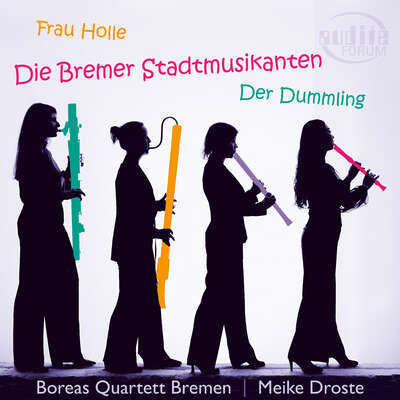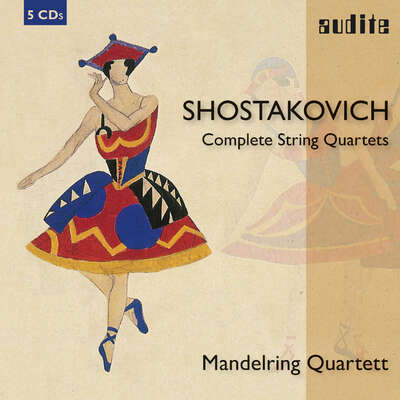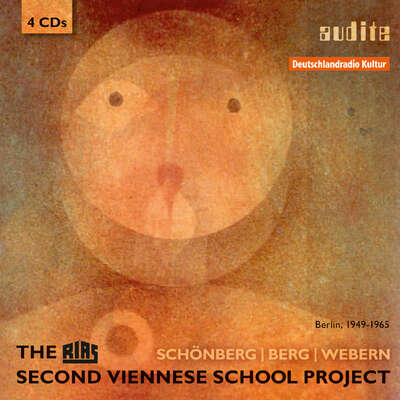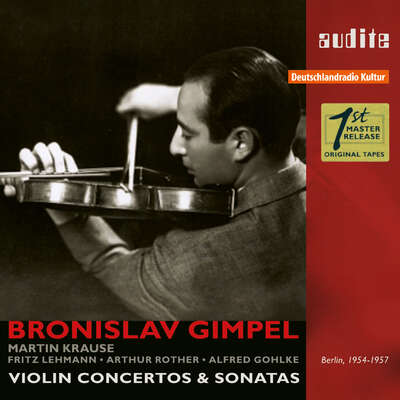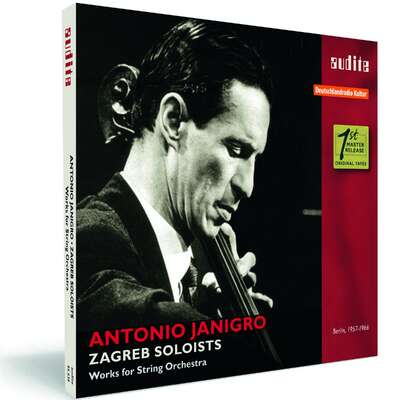
Wem die Ehrfurcht aller Komponisten vor der Gattung Streichquartett bekannt war, der konnte sich über das erste Quartett von Dmitri Schostakowitsch nur wundern: Was der immerhin schon 32-jährige Star der sowjetischen Komponistenszene im Jahr 1938 vorlegte, war ein frühlingshaftes,...mehr
"Wenn die kommenden Einspielungen auf diesem Niveau verbleiben ... bekämen wir vom Mandelring Quartett die Integrale schlechthin der Shostakovich-Quartette für das 21. Jahrhundert." (Pizzicato)
Details
| Dmitri Shostakovich: Complete String Quartets Vol. I | |
| Artikelnummer: | 92.526 |
|---|---|
| EAN-Code: | 4022143925268 |
| Preisgruppe: | ACX |
| Veröffentlichungsdatum: | 1. Februar 2006 |
| Spielzeit: | 72 min. |
Zusatzmaterial
Informationen
Wem die Ehrfurcht aller Komponisten vor der Gattung Streichquartett bekannt war, der konnte sich über das erste Quartett von Dmitri Schostakowitsch nur wundern: Was der immerhin schon 32-jährige Star der sowjetischen Komponistenszene im Jahr 1938 vorlegte, war ein frühlingshaftes, diesseitiges „Quartettino“ ohne Schwere und Tiefgründelei. Manche Beobachter sahen darin einen bewussten Akt der „Verweigerung“, vielleicht auch eine Reaktion auf die Maßregelung des Komponisten durch die stalinistischen Behörden. Erst sechs Jahre später bewies Schostakowitsch im zweiten Quartett (1944), was die Gattung für ihn noch an musikalischen Möglichkeiten bot. Mit der Form einer (neobarocken) Suite knüpfte er an die experimentellen Quartette des späten Beethoven an, während die Tonsprache an Tschaikowsky erinnert. Das vierte Quartett aus dem Jahr 1949, das der wiederum hart attackierte Komponist Jahre lang in der Schublade ließ, beginnt mit einer „ländlichen Szene“ und endet mit einem furiosen und grellen Finale im jüdischen Tonfall.
Das Mandelring Quartett beginnt mit diesen drei Werken seine Gesamtaufnahme der fünfzehn Streichquartette von Dmitri Schostakowitsch – eines imposanten Werkkorpus, der an Vielseitigkeit und enzyklopädischem Zugriff im 20. Jahrhundert nicht Seinesgleichen hat.
Besprechungen
Sikorski | August 2010 | 1. August 2010 Gesamteinspielung der Schostakowitsch-Quartette durch das Mandelring Quartett komplett
Die späten Streichquartette von Dmitri Schostakowitsch fallen in eineMehr lesen
concerti - Das Berliner Musikleben | Mai 2010 | Ulrike Klobes | 1. Mai 2010
Gemeinsam den Emotionen nachgehen
Das Mandelring Quartett und sein Berlin-Zyklus im Kammermusiksaal
Neustadt an der Weinstraße – von Berlin aus nicht gerade einMehr lesen
Universitas | Nr. 2/2010 | Adelbert Reif | 1. Februar 2010
Über den Grad der Bedeutung von Dmitri Schostakowitsch (1906-1975) fürMehr lesen
Diverdi Magazin | 189 / febrero 2010 | Pablo-L. Rodríguez | 1. Februar 2010
Shostakovichfest
El cuarteto Mandelring culmina una impresionante integral Shostakovich en Audite
El termino “Hausmusik” alude a la música pensada para su interpretación en casa por la familia y los amigos con el fin de entrerenerseMehr lesen
La carrera del Mandelring Quartett despegó en 1991 cuando ganaron en Munich el concurso internacional de música del ARD, el concurso Evian o se alzaron tres anos más tarde con el Premio “Paolo Borgiani" en Reggio Emilia. En esos años iniciaron también su carrera fonográfica en el sello Largo con la integral de los cuartetos de Berthold Goldschmidt (1903-1996), el último de los cuales les esta dedicado. Su siguiente proyecto lo realizaron enere 1992 y 2003 en el sello CPO y supuso la recuperación del noneto. uno de los 37 quinteros y nueve de los 34 cuartetos dei compositor francés Georges Onslow( 1784-1853). Y es que los cuatro miembros del Mandelring Quartett están profundamente implicados en dar rienda suelta a su curiosidad a la hora de diseñar provectos interesantes tanto para ellos como para los promotores v el publico. Precisamente el interés de I.udger Böckenhoff por ampliar el sello Audite, que había lanzado en 2000, a grandes proyectos fonográficos hizo que el Mandelring Quartett pasase a formar parce de su escuderla. Inicialmenre planificaron una integral de los cuartetos de Schubert que ha quedado detenida desde 2005 tras tres lanzamientos y que se ha combinado con un interesante proyecto iniciado en 2004 y concluido en 2007 de grabar los cuartetos de Brahms junto a otros de amigos y defensores suyos como Félix Otto Dessoff, Friedrich Gernsheim o Heinrich von Herzogenberg. No obstante, el provecto más prestigioso del Mandelring Quartett, y más aclamado por la prensa internacional, es la intergral de los cuartetos de Dimitri Shostakovich que iniciaron en 2006 y que acaban de concluir tras cinco lanzamientos.
El interés de estos cinco SACDs (a los que se añade el referido DVD con el segundo) no sólo reside en la calidad musical, sino también en la técnica. Creo que estamos ante la primera integral de los cuartetos del compositor sanpeterburgués en sonido envolvente y, si a ello le añadimos la marca de calidad sonora de Böckenhoff (que ya hemos comentado en estas páginas en relación con el cofre dedicados a las grabaciones de Furtwängler para la RÍAS: véase Boletín n° 181, págs. 38-39), el resultado no puede ser más satisfactorio a la hora de disfrutar con impresionante equilibrio, espacialidad y precisión de todos los detalles de cada interpretación. Estos cinco discos contienen una visión completamente nueva, donde cada uno de los cuatro músicos busca su personalidad sin detrimento del conjunto, sumamente intensa (el manejo de las tensiones es impresionante en algunas obras) y con un extraordinario predominio de la claridad formal (se consiguen versiones muy equilibradas), tímbrica (toda una lección de manejo del fraseo y de diferentes tipos de vibrare o golpes de arco) y dinámica (hay constrastes ciertamente de impacto) de estas quince obras excepcionales de la literatura para dieciséis cuerdas.
Cada lanzamiento incluye alguna versión excepcional e incluso el orden de su publicación resulta sumamente interesante para la escucha de todo el ciclo. El primer volumen se inicia con una versión fascinante de ese personalísimo divertimento shostakovichiano que es el Primer cuarteto o el Segundo impresiona por su mezcla de virtuosismo y entonación. El volumen dos resulta algo menos convincente pues se adopta un acercamiento cómodo y menos implicado; el Tercer cuarteto esta admirablemente locado (impresionante desarrollo fugado del primer movimiento) pero le falta humor negro. Su versión desgarradora de principio a fin del Octavo, que ha sido criticada por algunos por su enfoque de los dos últimos movimientos, puede resultar comprensible; recordemos que escuchamos a un cuarteto alemán en una efigie fúnebre personal compuesta tras una visita a Dresde en 1960. El tercer volumen, que incluye los retratos de las tres mujeres más importantes en la vida del compositor (su primera esposa Nina en el Séptimo, su segunda esposa Irina en el Noveno o su amante la compositora Galina Ustvolskaya en el Quinto) supera las trallas del anterior, al ahondar con mayor acierto en la uniformidad de los tempi (los lentos no demasiado lentos y los rápidos con más intensidad que velocidad), algo que, por cierto, también hacía el Cuarteto Beethoven que estrenó estas tres obras; de este lanzamiento Norberto Tauste publicó una breve reseña en el Boletín n° 174, pag. 53. El cuarto volumen sigue el camino ascendente marcado por el anterior con una versión del Décimo cuarteto admirablemente equilibrada de carácter y ahondando en los contrastes (excelente aquí la passacaglia) o un Duodécimo de corte intimista y profundizando en los coqueteos dodecafónicos del compositor ruso. Finalmente, el quinto volumen plasma con sorprendente precisión y riqueza de matices todas las caras de la muerte; resulta un digno colofón para este verdadero Shostakovichfest y culmina con una versión del Quincuagésimo cuarteto completamente personal y fascinante en esa sucesión de reflexiones funerarias contenidas en seis movimientos lentos.
Die Rheinpfalz | Mittwoch, 27. Januar 2010 Nr. 22 | Frank Pommer | 27. Januar 2010
Verstörte Seele
Angespielt: Das Neustadter Mandelring-Quartett beendet beeindruckend seinen fünfteiligen Schostakowitsch-Zyklus
Das Neustadter Mandelring-Quartett genießt dank seiner Konzerte und weitMehr lesen
www.sikorski.de | Januar 2010 | - | 15. Januar 2010
Gesamteinspielung der Schostakowitsch-Quartette durch das MandelringMehr lesen
Die Zeit | 26. November 2009, Die Zeit Nr. 49 | Volker Hagedorn | 26. November 2009
Das heimliche Tagebuch
Nirgendwo wird Dmitri Schostakowitsch so persönlich wie in seinen 15 Streichquartetten. Das Mandelring Quartett legt eine eindrucksvolle Gesamtaufnahme vor
Mit 66 Jahren fing das Leben vielleicht für Udo Jürgens an, aber nichtMehr lesen
Neue Zeitschrift für Musik | 4/2009 | Thomas Schulz | 1. Juli 2009
Die Streichquartette Dmitri Schostakowitschs enthalten vielleicht dasMehr lesen
Das Orchester | 11/2008 | Werner Bodendorff | 1. November 2008
Neun der insgesamt fünfzehn Streichquartette von Dmitri SchostakowitschMehr lesen
Frankfurter Allgemeine Zeitung | 19. Juli 2008 | Gerhard Rohde | 19. Juli 2008
Das Quartett als Spiegel der Welt
Dmitri Schostakowitsch hat in seinen fünfzehn Streichquartetten eine Art Tagebuch verfasst aus dunkler Zeit. Jetzt ist die Gesamtausgabe mit dem Mandelring Quartett komplett
Zu den Phänomenen der gegenwärtigen Musik, auch des Musikbetriebs,Mehr lesen
ionarts.blogspot.com | Thursday, May 29, 2008 | jfl | 29. Mai 2008 Shostakovich with the Mandelring Quartett
Shostakovich’s String Quartets are, alongside those of Bartók, Villa-Lobos, and possibly Bloch, the towering [20th century] achievements in thatMehr lesen
Just as it has become the norm for every better orchestra to record a Mahler symphony cycle in the last ten years, it’s part of the good tone for aspiring and established string quartets to delve into Shostakovich cycles. After the pioneering Beethoven (Legendary Treasure), Shostakovich (Regis), Fitzwilliam (Decca), and Borodin String Quartets (an early cycle on Chandos Historical and a complete one on Melodiya) had completed their cycles, there was little to challenge the primacy especially of the latter two until the Emerson String Quartet darted into the relative void with their squeaky clean, live cycle from Aspen on DG. Since then complete cycles have been added by the Brodsky (Warner), Sorrel (Chandos), St. Petersburg (Hyperion), Éder (Naxos), Rubio (Brilliant), Manhattan (Ess.a.y), Danel (Fuga Libera), and Rasumovsky (Oehms, not yet available)Quartets.
One of the most exciting prospects for a cycle of Shostakovich quartets these days is the Israeli-Russian Jerusalem Quartet. They have two recordings of DSCH out, so far, and the leisurely pace seems to be beneficial to the project, assuming a whole cycle is planned. Definitively planning a complete cycle is the Mandelring Quartett from Germany who have arrived on volume three of five of their multi-channel SACD project. I have enjoyed them live and on disc – and in particular their innovative Brahms cycle - coupled with neglected contemporaries like Dessoff – has piqued my interest.
The first two instalments of this group, consisting of the siblings Sebastian, Nanette, and Bernhard Schmidt (violins and cello, respectively) as well as violist Roland Glassl, have already picked up several recommendations – promises of excellence that the third, which includes String Quartets nos. 5, 7, and 9, seems to hold.
Serving as my primary comparison for these recordings is the second Borodin cycle – newly re-mastered and released on Melodiya and more than ever my favorite for the emotional grit and grip that they exude. The sound, formerly “good enough”, is now very fine indeed; the background hiss audible, but even on headphones never intrusive – a definite improvement on the old BMG-distributed cycle.
String Quartet no.7, a sorrowful little number dedicated to the memory of his first wife Nina Vassilyevna Shostakovich who had died of cancer in 1954, is – in the inimitably translated liner notes of the Melodiya release – “a more little of all Shostakovich’s quartets. But there’s said a lot – and said newly.”. Indeed. The opening movement (Allegretto) has a light flexibility, deliberate elasticity with the Mandelring Quartett (3:34); the Borodin is notably faster (3:19) with more anguished peaks. The Hagen Quartett, whose latest disc includes this quartet (as well as nos.3 and 8), is more like spun silver threads; a perfection of individual voices.
The slow Lento movement highlights the Hagen’s individual excellence and separation again – whereas the Mandelrings sound a little hazier. But whereas the Hagens are utterly gloomy here, catching a grove only very late in the shortest of movements (2:46 with the Hagen, 2:52 with the Mandelring, and 3:34 with the Borodin), the Mandelring is comparatively bright. The Hagen Quartet seems to celebrate slacking dystopia and shapelessness, the Mandelring finds more purpose. Neither could possibly sustain the movement over three and a half minutes in the way that the Borodin does, without ever dropping the musical thread. Their take is not gloomy but steady – offering a constantly moving pulse throughout, lyrical toward the end, and almost unnoticeably slow.
Even the speedy and wild(er) third movement – Allegro – has a dark, melancholic, even lethargic undertone, a trace that all the busyness on the surface cannot dispel. It’s not unlike the 8th Symphony, in a way, but a merciful 50 minutes shorter. The Mandelring (5:11) buzz along with abandon and the superb sound on this Audite disc comes to the fore, especially where Bernhard Schmidt’s cello gets all the room to bloom that it needs. Just one detail, a possible caveat: alone, they sound pretty nice, even at the densest and wildest moments. Cut to the Borodin (at 5:35 again the slowest of the three) – and you notice the difference. The latter rip into the music with more pointed accentuation and a gusto that seems to put their poor instruments in immediate danger.
At high volumes the Mandelring quartet sounds weighty and beautiful, the Borodin shrill to the point of unbearable. Which of these two you find a recommendation or warning in a Shostakovich quartet will depend entirely on what it is that you want to get out of these works. If you have made proper acquaintance with them, you will undoubtedly have a preference already. The Hagen (5:16), not unlike the Borodin, but with frightening assuredness and accuracy, instead of frighteningly free-wheeling, rip through the first three minutes like the half-demented.
Judging by the Seventh Quartet, one might expect the Fifth Quartet to be something slightly mellower in the hands of the Mandelring Quartett by comparison with the Borodin’s version. Instead, they bulldoze through the opening Allegro non troppo with an intensity that rivals the Borodin every step of the way. Only at their wildest moments – this time due to the better, fuller sound, not because of lacking aggressiveness – are they less shrill than the Borodin’s who have the more delicate, even sweet, moments in the gentle, pizzicato-dominated closing pages.
In String Quartet no.9, the Borodin are at their most bracing. Perhaps this has to do with the fact that – like Quartet no.6 and the Piano Quintet with Sviatoslav Richter – it was recorded live. Some additional background noise, more reverberation and curious balances make the difference between Audite’s impeccable and Melodiya’s raw sound far more notable.
Listen to the third movement (Allegretto furioso), where the Mandelring Quartett doesn’t gallop into this movement like mad, as does the Borodin Quartet. Rather it starts as a graceful, agile dance, replaced by sudden vigour and anxious terror. The Borodin move from madly riveting to a brutal, metallic harshness that disabuses the listener of the idea that this might be the “Quartet for Children” that Shostakovich had promised the Beethoven Quartet for their 40th anniversary. Unless the same misunderstanding regarding “Toys and spending time in the open air” occurred here as it did in his 15th Symphony – distinctly not a toy-shop symphony, despite Shostakovich’s claims to that effect – the 1964 9th String Quartet is in fact a different, new work than the one he promised to produce with those words in 1952. You could also consider a link between the reoccurring galloping spiccato beat of the Allegretto to the “William Tell” quotes in the 15th Symphony, but if the similarity is anything but coincidental would be difficult to prove. When it finally saw the light, Shostakovich dedicated the quartet to his new, third, wife, Irina Supinskaya.
When anxiety and strife give way to the agonizing Adagio, the calm deliberation and the atmospheric sound of the Mandelring Quartet (3:03) are every bit as raw and tender as the much slower Borodin (4:04). Their concluding Allegretto is a strident highpoint of this release.
The peaks and extremes of the Borodin, not to mention the frequently abrasive sound – which I find quite appropriate most of the time – make that cycle stand out more and may be more immediately captivating or exciting. But especially on repeat- and closer listening, the Mandelring’s carefully considered, always unpredictable ways are a treasure, not only for audiophiles but for all who want more than the “authentic Russian” version of the Borodin, Beethoven, or Shostakovich Quartets.
Muzyka21 | 5 (82) - maj 2007 | Katarzyna Musiał | 1. Mai 2007
Mandelring Quartett, firmowany przez wytwórnię Audite, po raz kolejnyMehr lesen
Fanfare | March/April 2007 | Barry Brenesal | 1. März 2007
This is the first release in a new series featuring the Mandelring Quartet, a relatively young ensemble that has already recorded extensively. IMehr lesen
But I really don’t think they have the measure of Shostakovich, here. This isn’t 19th-century chamber music, music-making for music’s sake. The Shostakovich quartets, with very few exceptions, perform the role of private diary to the composer’s emotions. It’s no secret that they reveal the pain of friends and lovers dying, the unremitting hatred of a stupid, dictatorial regime, or the anguish over personal treatment and universal suffering. While the First Quartet is something of an exercise in form and the lightest of the group, the Second is already a work that gets into the grit of torment; not surprisingly, considering the level of misery that Shostakovich saw everywhere after the German invasion. The String Quartet No. 4 was one of several works the composer left “in the drawer” after his second major run-in with the authorities led to loss of employment, prestige, and funds. It wasn’t performed publicly until nine months after Stalin’s death, and showed an uncompromisingly angry, bleak vision of life.
You won’t get anger, bleakness, ridicule, or anguish out of these performances, however. They are beautiful of their kind, being well played, varied in tone, and exceptionally effective in bringing out inner voices. But that’s the limit of their efforts. These performances might as well be of any Classical period composer as of Shostakovich, for all the emotional weight they bear.
Consider the songful Andantino of the Quartet No. 4, referred to in the Manderling’s liner notes as a “broken-winged waltz à la Tchaikovsky.” Not by half, it isn’t. The piece is one of those despairing, lost soul movements that Shostakovich placed in several of his symphonies; and this is the most songful and heartrending of them all. The Shostakovich Quartet (on Regis 5001) gives its bleak lyricism full value, moving from full chords treated richly à la Borodin Quartet, to a wan, vibrato-drained sound. The Mandelrings here are considerably faster than the tempo marking, and restrained to the point of removing much of the piece’s emotional arch. Timings can’t tell all, but they tell us something: the Shostakovich Quartet takes 7:16, the Mandelring Quartet requires only 5:33.
The contrast is greater still in the Scherzo movement that follows. The Mandelrings chug along at a moderately slow clip, with little attempt to reproduce the hushed eeriness of the work. The oppressive march section is—well, the only word I can find to describe their efforts would be polite. It sounds tuneful, even jolly. The Shostakovich musicians take matters at an energetic allegretto as marked, and make much more of both the expressive violin passages and the subsequent march. The latter sounds properly grotesque, with the trumpet-like motif smartly rapped out. Dynamics are more hushed throughout, and although the ambience is overly dry, the overall results are more effective in creating the kind of impression Shostakovich desired.
There is certainly room for interpretative difference in these quartets, as the recordings of the Fitzwilliam (Decca 455776), Borodin (Chandos 10064), Rubio (Brilliant Classics 6898), and Brodsky (Warner 60867) Quartets reveal. But throughout the Fourth String Quartet and to a lesser extent in the Second, the Mandelring Quartet gives us the notes, all the notes, and nothing but the notes. No, that’s not quite right: they give us the notes in an 18th-century context when for the most part, Haydn-influenced chamber music was about courteous musical interplay, and not the details of personal emotional upheaval. This, then, is Shostakovich as Haydn.
The sound is as beautiful a thing as I could wish on a string quartet, suave and balanced in stereo, with a reasonable degree of added hall spaciousness in surround sound. Too bad it isn’t put to better use, for the Mandelrings are out of their element, here.
Audiophile Audition | January 2007 | Gary Lemco | 13. Januar 2007
Heady, understated but passionate music, exquisitely played and recorded, aMehr lesen
Kölner Stadtanzeiger | Nr. 265/2006 | Michael Struck-Schloen | 15. November 2006 Aggression und Verletzlichkeit
Neuaufnahmen mit Musik von Dmitri Schostakowitsch – ein Streifzug<br /> ZumMehr lesen
Zum
American Record Guide | November/December 2006 | Keaton | 1. November 2006
Dmitri Shostakovich has been called the 20th Century's greatest composer on the pages of this journal, and his canon of 15 quartets must be recognizedMehr lesen
These two recordings illustrate two different approaches to the composer's music. The Mandelring Quartet is a German group, and their Audite recording is marked Complete Quartets, Vol. 1. It is a hybrid SACD recording, and sounds wonderful on my conventional equipment. The group plays with magnificent technical finish and superb control, but I find their interpretation lacking. Shostakovich's music is deeply emotional, sardonic, angry, tragic. It is a response to a life out of control. The strongest interpretations may lack finish and control, but will explore the darker side of existence. This region may be troubling, disturbing, but it is what Shostakovich's creative and human life was like.
The First Quartet is not really a harbinger of what was to come. The composer set it in the innocent key of C and called it “quartettino”. It reminds me of the simplicity and purity of the first of the 24 Preludes and Fugues in the same key. But even this work has a hint of the unsettled that is somehow missing here.
The Fourth Quartet is somewhat similar in its more reserved, classical balance. Yet it was composed in the wake of Shostakovich's public humiliation by Zhdanov's accusation of formalism (Soviet code for music Stalin could not understand). It hardly seems challenging to ears used to Bartok and Schoenberg, but Shostakovich would not allow a public presentation until weeks after Stalin's death. We now know that there were several private performances of the work.
Again, the Mandelring's performance is technically assured, even moving. But compare the last movement here with the Fitzwilliam (London), where slashing chords and pizzicatos are more intense, melodies soar in more pain and defiance, and passages of devastation are emptier, darker.
The St Lawrence Quartet in 3, 7, and 8 is another story entirely. They are every bit as technically accomplished as the Mandelring, but this youngish group takes us on a wild ride, a trip through a troubled psyche, a troubled society, a troubled world, but a world where beauty of spirit finally can overcome.
No. 3 was written in 1946. Stalin had made it clear to Soviet artists that the triumphal conclusion of the war would not lead to any relaxing of state control over their work. Shostakovich's response was to create a work of violence, anger, sarcasm, and pessimism. He originally gave the five movements titles: Rumblings of Unrest and Anticipation; Calm Unawareness of the Future Cataclysm; The Forces of War Unleashes; Homage to the Dead; and The Eternal Question: Why? And for what? He withdrew these before publication.
No. 7 was composed in 1960, to the memory of the composer's first wife, Nina. It is also his first quartet in a minor key. The work is remarkable in its concision. It is the shortest of all of his quartets, lasting barely 14 minutes. The spare textures of the II are fascinating. It consists mainly of solos, duos, trios; only for six bars are all four instruments playing.
No. 8 also dates from 1960, composed after a visit to Dresden to witness that city's devastation from the War. It is officially dedicated To the Memory of the Victims of Fascism but is secretly autobiographical. The opening movement is based on the motto D-E-flat-C-B — in German DSCH, for Dmitri Shostakovich. Quotations are heard from the First Cello Concerto and Lady Macbeth of Mtsensk, and IV has a familiar prisoner's song, 'Tormented by the Lack of Freedom’, which must have been especially poignant for Shostakovich.
The St. Lawrence’s tempos tend to be slower than the Fitzwilliam in slow movements, faster in fast movements, but not extremely so. Their tempos are generally slower than the Emerson’s (but whose aren’t?). Each of the three performances was enthralling, and emotionally exhausting. I look forward to further Shostakovich performances by the ensemble.
Pforzheimer Zeitung | Nummer 221 | Thomas Weiss | 23. September 2006
Gewichtige Beiträge zum Schostakowitsch-Jahr liefert das Hagen-QuartettMehr lesen
Cellesche Zeitung | 09/2006 | Reinald Hanke | 19. September 2006 Quartett-Geheimtipp
Seltsam: Das Mandelring-Quartett hat schon viele Jahre einen guten Ruf,Mehr lesen
www.amazon.com | September 2006 | Edith Eisler | 14. September 2006
Composers have always entrusted their most intimate personal feelings to the string quartet, but Shostakovich went further: he used them to encodeMehr lesen
www.ClassicsToday.com | September 2006 | Jed Distler | 9. September 2006
If future releases in the Mandelring Quartet's projected Shostakovich cycleMehr lesen
Classica-Répertoire | septembre 2006 | Stéphane Friédérich | 1. September 2006 Chostakovitch dans les bacs
Le centenaire de la naissance du compositeur russe est célébré par uneMehr lesen
www.classicalcdreview.com | August 2006 | R.E.B. | 1. August 2006
Superb sonics combine with superior performances on Audite's well-filledMehr lesen
SWR | Plattenprisma | Thomas Rübenacker | 8. Juli 2006
Guten Tag, meine Damen und Herren, herzlich willkommen zu diesemMehr lesen
Fono Forum | 7/2006 | Martin Demmler | 1. Juli 2006 Taktischer Rückzug
Als Dimitri Schostakowitsch sein erstes Streichquartett komponierte, hatte er bereits fünf Sinfonien sowie zwei avancierte Opern vorgelegt.Mehr lesen
Geradezu klassizistisch wirkt sein 1938 entstandenes erstes Streichquartett, harmonisch simpel in C-Dur gehalten und durchsetzt von tänzerischen Rhythmen. Doch hinter dieser Fassade scheint immer wieder der wahre Schostakowitsch durch, ob in den ungewöhnlichen harmonischen Rückungen der langsamen Einleitung des Kopfsatzes oder in den grotesk-stürmischen Passagen des Finales. Gerade diese Elemente sind es, die das Mandelring-Quartett in seiner Interpretation betont. Eine ungemein inspirierte und klar strukturierte Aufnahme.
Geradezu volkstümlich gibt sich das 1944 entstandene zweite Quartett: Russische Volksweisen und Walzerklänge fasst Schostakowitsch zu einer suitenhaften Satzfolge zusammen. Auch hier betonen die Interpreten das Abgründige dieser Musik, die zwischen Totentanz und einer unwirklichen Fröhlichkeit changiert.
Das vierte Streichquartett wagte der Komponist erst nach dem Tod Stalins zu veröffentlichen, vier Jahre nach der Entstehung, obwohl auch in diesem Werk folkloristische Töne vorherrschen, vom Mandelring-Quartett schmissig und mit viel Verve umgesetzt.
opushd.net - opus haute définition e-magazine | Numéro 7 | Jean-Jacques Millo | 9. Mai 2006
Pour ce premier volume, d’une intégrale annoncée, des Quatuors àMehr lesen
The Strad | May 2006 | David Denton | 1. Mai 2006
Still viewed with suspicion by his political adversaries, ShostakovichMehr lesen
Mannheimer Morgen - Morgen Magazin | 13. April 2006 | dms | 13. April 2006 Perfekte Balance
Weder mit den stilistischen Mitteln, noch in dem musikalischen Material,Mehr lesen
Stereo | 4/2006 | Egon Bezold | 1. April 2006
Wer sich auf die voller Hintergründigkeiten und beklemmende FahlheitMehr lesen
Ensemble - Magazin für Kammermusik | 2/2006 | Carsten Dürer | 1. April 2006 Mit viel Elan
Was kann man erwarten von solch einem ernsthaften wie berauschend gutenMehr lesen
Pizzicato | 4/2006 | Guy Wagner | 1. April 2006 Annäherungsversuche
Annäherungsversuche an die gewaltige Musikwelt des Dmitri Shostakovich, dessen 100. Geburtstag ins Haus steht, kann es nicht genug geben, und somitMehr lesen
[...]
In dieser Hinsicht spielt die geplante Neueinspielung durch das Mandelring Quartett (Sebastian und Nanette Schmidt, Violinen, Roland Glassl, Viola, und Bernhard Schmidt, Cello) auf einer ganz anderen Ebene. Selten hat man eine so ausgewogene und durchsichtige Tonaufnahme gehört wie auf dieser SACD.
Gleiches gilt für die Qualität der Interpretationen. Dies sind nun in der Tat Deutungen, die weit über Annäherungsversuche an den Komponisten hinausgehen und sehr persönliche und überzeugende Lösungen darstellen. Wenn das 1. Quartett noch etwas von Unbeschwertheit hat, das ihm gut steht als Herausforderung sozusagen an die bitterböse Zeit von 1938. Danach versinkt das 2. Quartett von 1944 in jener Tragik, die so viel über ihren Schöpfer aussagt: Wie das Mandelring Quartett das unglaubliche Rezitativ und Romanze gestaltet, oder das Einleitungs-Allegretto zum 4. Quartett, die federnde Präzision des 3. und die jiddische Atmosphäre des 4. Satzes (ebenfalls Allegrettos, aber jedes so anders als das erste), - das erreicht Dimensionen von solcher Eindringlichkeit und spielerischer Perfektion, dass man nur sagen kann: Wenn die kommenden Einspielungen auf diesem Niveau verbleiben, mit noch etwas zusätzlichem Biss, bekämen wir vom Mandelring Quartett die Integrale schlechthin der Shostakovich-Quartette für das 21. Jahrhundert.
www.SA-CD.net | March 17, 2006 | Robert Greer | 17. März 2006
Well, at least for now, this is my favorite SA-CD, for a number of reasons.Mehr lesen
Zeitzeichen | Jg. 7, März 2006 | Ralf Neite | 1. März 2006
Im Widerstreit
Alle Shostakovitch Quartette
Es war in den Jahren der „Großen Säuberung“ zwischen 1935 und 1939. In der Sowjetunion wurden auf Stalins Anordnung hin Millionen von MenschenMehr lesen
Die Werke, die er in den folgenden Jahren schrieb, sind ein musikalischer Spagat. Einerseits durften sie nicht dem Vorwurf zuspielen, Schostakowitsch komponiere avantgardistischem Formalismus, der am Geschmack des Volkes vorbeigehe. Andererseits spiegeln sie unverändert hohe künstlerische Ambitionen wider. Die berühmte fünfte Sinfonie wurde vielfach als Anbiederung an das Regime verstanden, doch wer so dachte, hatte ihre ironischen Untertöne überhört. In dieser Zeit entstand auch das 15-minütige Quartettino, vordergründig neoklassizistisch und unbeschwert. Doch unter all den Zitaten von Mozart bis Mahler sind Falltüren verborgen, die sich erst bei sehr genauem Zuhören öffnen.
Dieses Streichquartett Nr. 1 in C-Dur war für Schostakowitsch der Beginn einer 30-jährigen Auseinandersetzung mit der Gattung. Kein anderer Komponist des 20. Jahrhunderts ist so tief in dieses Sujet eingedrungen wie der 1906 geborene und 1975 gestorbene Russe. Das Mandelring Quartett hat es sich nun zur Aufgabe gesetzt, alle 15 Werke neu aufzunehmen.
Die erste CD aus dieser Reihe enthält neben dem Quartettino noch die Streichquartette Nummer zwei und vier. Beide stehen in Dur-Tonarten (D und A) und sind doch von einer großen Dunkelheit geprägt. Man tut gut daran, sich von den Satzbezeichnungen nicht täuschen zu lassen. „Rezitativ und Romanze“ im A-Dur-Quartett etwa sind von eindrucksvoller Dramatik, in der Sebastian Schmidts Violine ihr betörendes Klagelied singt. Und der anschließende Walzer entpuppt sich als wahrer Totentanz.
Das Mandelring Quartett spielt Schostakowitschs Musik mit sattem Klang, der die Nuancen doch nicht aus dem Blick verliert. Mitunter könnte man sich einen etwas harscheren Ton vorstellen, zumindest im vierten Quartett, das der Komponist mehr als vier Jahre in der Schublade versteckt hat – bis nach Stalins Tod. Doch auch die vorliegende, sehr emotionale Interpretation ist schlüssig: Das Mandelring Quartett zeigt Schostakowitsch als Genie im Widerstreit von Neuerung und Beschränkung, dessen Geist wieder und wieder in große Traurigkeit verfiel.
Badische Zeitung | Donnerstag, 23. Februar 2006 | Johannes Adam | 23. Februar 2006
Die Gattung fürs Leben
Mandelring-Quartett startet Gesamteinspielung der Streichquartette Dmitri Schostakowitschs
Die zentrale Gattung der Kammermusik ist das Streichquartett. Häufig ist es auch Indikator für den jeweiligen Stand von Tonkunst und Komponieren.Mehr lesen
Mit den Nummern 1, 2 und 4 legte das Mandelring-Quartett jetzt beim Detmolder Label „audite“ die erste SACD seiner Gesamteinspielung sämtlicher Schostakowitsch-Quartette vor. Dass das Cover mit tänzerischen Motiven geschmückt ist, mag auf den ersten Blick überraschen. Beim Hören bestätigt sich dann rasch die Richtigkeit der Wahl. Mitunter zeigt die Musik – auch in ihren Momenten der Stilisierung und Verfremdung – eine gewisse Nähe zum Tanz. Sie trippelt dahin. Sogleich wundert man sich: über das Tändelnde, fast Unverbindliche des allerersten Quartetts, das zudem ja in der scheinbar so simplen Tonart C-Dur steht. Nicht weniger als fünf gestandene Sinfonien existierten bereits, als Schostakowitsch sich erstmals dem Streichquartett zuwandte. Und dann dieses Werk! Das wie eine Studie, wie ein Präludium als Hinführung zur Gattung wirkt. Achtung: Bei diesem Autor kann Musik einen doppelten Boden haben. Spekulationen über Anlässe und Adressaten sind erlaubt.
Mandelring-Quartett: Das sind die Geschwister Sebastian und Nanette Schmidt (Violine) sowie Bernhard Schmidt (Cello), zu denen sich der Bratscher Roland Glassl gesellt. Jene vier Musiker, für die Quartettspielen erklärtermaßen der „Traumberuf“ ist. Beim Münchner ARD-Wettbewerb haben sie reüssiert, bei uns kennt man sie vom Markgräfler Musikherbst. Schubert haben sie aufgenommen, zudem Werke von Brahms und seinem heute kaum mehr bekannten Zeitgenossen Friedrich Gernsheim, auch Georges Onslow oder Berthold Goldschmidt.
Dies und die damit gesammelte Erfahrung sind günstige Voraussetzungen für
Schostakowitsch. Die Mandelrings bieten ihn engagiert, ausdrucksvoll, doch unaufdringlich und ohne erhobenen Zeigefinger. Die Interpretationen sind genau und fernab jeder Künstlichkeit. Tonschönheit ist keineswegs Nebensache, wird aber auch nicht verabsolutiert. Die Streicher spüren den Strukturen besonders dort subtil nach, wo sie melodisch sind. Merke: Dem 20. Jahrhundert ist noch vertraut, was Melos meint. Ruhe und Lyrik finden die nötige Beachtung. Obendrein auch die schier unstillbare musikantische Energie Schostakowitschs. Im Kontext des Œuvres geben die Quartette, denen ein humaner Anspruch innewohnt, Auskunft über Welt und Leben. Und über den Komponisten. Das Mandelring-Quartett offeriert eine breite Palette der Nuancen des Leisen und der Farben. Schostakowitsch – comme il faut. Diese Scheibe ist viel versprechend. Auf die weiteren darf man gespannt sein.
Deutschlandfunk | 5. Februar 2006 | Norbert Ely | 5. Februar 2006
Seien Sie herzlich willkommen zu neuen Aufnahmen aus dem Genre der Kammermusik. Die zweite CD, über die Sie heute morgen informiert werden sollen,Mehr lesen
Das Mandelring Quartett zeichnet mit seiner ersten CD der geplanten Anthologie sämtlicher Streichquartette Schostakowitschs hingegen einen langsamen und konsequenten Prozess nach. Es ist ein Prozess der emotionalen Verdichtung und zugleich der inneren Befreiung. Die CD, die bei audite erschienen ist, umfaßt die Streichquartette Nr.1 C-dur, Nr.2 A-dur und Nr.4 D-dur, also ein Werk aus der Vorkriegszeit, jedoch nach der ersten Maßregelung des Komponisten durch die „Prawda“, ein Werk aus dem Kriegsjahr 1944 und ein Quartett aus der Zeit nach der zweiten Maßregelung. Natürlich wissen die Mandelrings um die biografischen Zusammenhänge. Aber sie tun das einzige Richtige: sie vertrauen der Musik. Sie spielen Schostakowitsch mit einer Noblesse der Tongebung und einer Delikatesse der harmonischen Beziehungen, als habe sich dieser Komponist in Wahrheit auf der Suche nach der verlorenen Zeit befunden. Und plötzlich atmet diese Musik eine innere Freiheit, gewinnen die Dissonanzen eine klangliche Schönheit, als seien diese Quartette nicht mehr von dieser Welt. Allenfalls ein leiser Grundton von tiefer Trauer zieht sich hindurch.
[Hörbeispiel: D. Schostakowitsch: Streichquartett Nr. 1 C-dur op. 49, 3. Allegro molto]
Klingt der dritte Satz aus dem ersten Streichquartett von Dmitri Schostakowitsch in der Neuaufnahme mit dem Mandelring Quartett noch vergleichsweise verbindlich, so setzt die äußerst differenzierte Tongebung bei den Variationen im Finale des zweiten Streichquartetts jene untergründigen und bedrohlichen Energien frei, die sich überall im späteren œuvre dieses Komponisten finden. Auch hier freilich sorgt die ungewöhnlich sensibel ausgehörte Polyphonie für harmonische Beziehungen, die immer wieder von geradezu archaischer Schönheit sind.
[Hörbeispiel: D. Schostakowitsch: Streichquartett Nr. 2 A-dur op. 68, 4. Thema mit Variationen]
So vollendet das Mandelring das 2.Streichquartett von Dmitri Schostakowitsch spielt – am eindrucksvollsten gelingt ihm eben doch das vierte Quartett op. 83. Aus der kühneren, drängenden Harmonik entwickelt das Ensemble Klangfarben, die lichter erscheinen als in den Aufnahmen anderer Quartettformationen, reiner und klarer auch, und denen doch nichts an Prägnanz der Aussage, an konsequenter Haltung abgeht. Ein wenig spürt man den historischen Abstand. Aber das hat, wenn die Auseinandersetzung mit Vergangenheit auf einem so hohen instrumentalen und konzeptuellen Niveau erfolgt, durchaus seine Legitimation.
[Hörbeispiel: D. Schostakowitsch: Streichquartett Nr. 4 D-dur op. 83, 3. Allegretto]
Das war die neue Platte im Deutschlandfunk. Zum Schluß hörten Sie das Mandelring Quartett mit dem dritten Satz, Allegretto, aus dem vierten Streichquartett D-dur op. 83 von Dmitri Schostakowitsch. Die CD ist bei audite erschienen. Am Mikrofon bedankt sich Norbert Ely für Ihre Aufmerksamkeit.
Midem News | January 2006 | 1. Januar 2006
Audite, on the other hand, pays tribute to Shostakovich, issuing the firstMehr lesen
